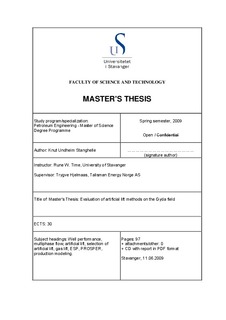| dc.contributor.author | Stanghelle, Knut Undheim | |
| dc.date.accessioned | 2010-02-02T15:16:59Z | |
| dc.date.issued | 2009 | |
| dc.identifier.uri | http://hdl.handle.net/11250/183243 | |
| dc.description | Master's thesis in Petroleum engineering | en |
| dc.description.abstract | Since a production peak in 1995 the oil production on the Gyda field has decreased.
Water cut is increasing and reservoir pressure is decreasing. This thesis is a study of
the artificial lift methods being evaluated to increase the production in the late life of
the field.
A thorough investigation of gas lift and Electrical Submersible Pump (ESP) theory,
design, and production output is carried out. The theory of artificial lift selection is
also presented.
Based on reservoir inputs and completion design, production has been simulated in
PROSPER for different scenarios and methods.
The main conclusions and recommendations are as follows:
• Gas lifting is a simple, well tried method where little can go wrong, while
ESPs are a complex solution which will require a large amount of planning
and administrative resources.
• ESPs have a limited lifetime which increases cost later in a project. The
expected lifetime of an ESP well on Gyda is two years. The initial cost for a
gas lift well and ESP well will not be so different, because a lot of the wells
need a full workover before they can be used for gas lifting.
• Production through gas lifting is not only dependent on injection rate, but can
be optimized through the completion design. Setting the valves deeper gives
an increased production.
• A new gas compressor is needed if a gas lifting campaign is to be initiated.
• Baker Hughes Centrilift’s ESP design was verified for the start up (May 2010)
conditions. But production can fall beneath minimum design rate after some
years, and a new evaluation of design must be done when the pumps are
changed at failure.
• The production simulation of the pilot wells A-19 and A-26 shows that the
ESP solution is superior to the gas lift. A secondary effect from the ESP
pressure drawdown can also increase production and recovery factor for the
field.
• Even though ESPs seem to be the superior choice, an economical evaluation
of the projects entire lifetime is needed. A Net Present Value analysis will give
the different projects a comparable value, which includes the costs and
production from start to finish. | en |
| dc.format.extent | 2064655 bytes | |
| dc.format.mimetype | application/pdf | |
| dc.language.iso | eng | en |
| dc.publisher | University of Stavanger, Norway | en |
| dc.relation.ispartofseries | Masteroppgave/UIS-TN-IPT/2009 | en |
| dc.subject | petroleumsteknologi | en |
| dc.subject | well performance | en |
| dc.subject | multiphase flow | en |
| dc.subject | artificial lift | en |
| dc.subject | selection of artificial lift | en |
| dc.subject | gas lift | en |
| dc.subject | ESP | en |
| dc.subject | PROSPER | en |
| dc.subject | production modeling | en |
| dc.title | Evaluation of artificial lift methods on the Gyda field | en |
| dc.type | Master thesis | en |
| dc.subject.nsi | VDP::Technology: 500::Rock and petroleum disciplines: 510 | en |
